![]() Introduction
Introduction
![]() What Causes Cows to Show
Heat?
What Causes Cows to Show
Heat?
Although high estrogen and low progesterone are considered the hormonal prerequisites for expression of heat, these hormones are not the ultimate signals that induce signs of heat. The specific ultimate signals are unknown, but they include classical neurotransmitters and possibly neuropeptides. Some physiological signs of heat such as edema and hyperemia of the genitalia and secretion of cervical and vaginal mucus are involuntary. But the more important behavioral signs such as standing, mounting, licking, butting and head-resting are voluntary reflexes that are influenced greatly by existing conditions in the cow's immediate environment (1).
![]() What Affects Expression of
Heat?
What Affects Expression of
Heat?
Behavioral signs of heat generally require that at least two animals interact. Studies in our laboratory indicate that secondary behavioral signs such as butting, licking and head-resting are influenced less by a cow's immediate environmental conditions than are the primary behavioral signs, mounting and standing (24). Most experienced observers utilize these secondary signs to pick out cows that are most likely to be in heat even when the immediate environmental conditions limit mounting and standing activity.
A cow will not be detected to stand if there is no other animal willing to mount. Mounting activity is stimulated strongly by estrogen and inhibited strongly by progesterone (25). Thus, mounting frequency is considerably greater for cows in proestrus or estrus than for cows that are out of heat or in midcycle (9, 25). Once there are four or more sexually active animals (proestrus or estrus) in a group, then mounting activity will normally be sufficient for efficient detection of heat (9). Mounting behavior has a fairly high repeatability, and cows that are active mounters during one lactation are also more active during their next lactation (25).
Mounting activity is influenced considerably by the cow's immediate environment. We
studied mounting and standing activity in high producing Holstein cows during six months
after calving (4). Ovaries of these cows were removed and then the cows were given low
doses of estrogen every four weeks throughout lactation to stimulate sexual behavior. We
found that standing activity was constant throughout the six months after calving, and that
higher producers tended to stand more than lower producers. In contrast, mounting
activity increased during the six months after calving. Mounting activity was also higher in
high producing cows. The most important observation that we made was associated with
the location where cows were checked for heat. During the study, cows were watched for
1 hr every 8 hr after the estrogen treatment. During each of these 1-hr checks, the cows
were on dirt for 30 min and on a dry grooved concrete alley for 30 min. The results are
shown in Table 1.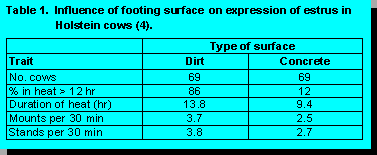
These results show quite clearly that mounting and standing activity and length of estrus were greater on dirt than on concrete. When the length of heat was estimated from observations on dirt, the average heat lasted nearly 14 hours, and 86% of the heats were longer than 12 hr. However, when observations on concrete were used to estimate these same variables, we found that the average heat lasted about 9 hr and only 12% of the cows were in heat for more than 12 hr. Thus the same cows during the same heat periods expressed substantially more activity if they had access to a dirt lot. This has important implications in designing a heat detection program. It suggests that getting cows off concrete when they are checked for heat should result in better efficiency in detection of heat. If cows are moved onto dirt lots for heat detection, it is advisable to have a well-drained lot so footing conditions are good.
We also found that mounting activity was greatest just after cows were moved to a different location, particularly if this location was a dirt lot with good footing (4, 24). We have noted that cows reduce physical activity such as mounting when the footing surface is poor, but they do not reduce secondary sexual behaviors such as licking the vulva, chin resting, butting and other agonistic behaviors seen in cows that are in heat.
Table 2 indicates relative mounting activity that one might expect to observe in various
locations and conditions on dairy farms. These empirical values are based on data from
several published and unpublished studies and on casual observations made on many
farms. A value of 1.0 is assigned to mounting activity expected to occur on a relatively dry
grooved concrete alley. A higher index means more mounting activity.
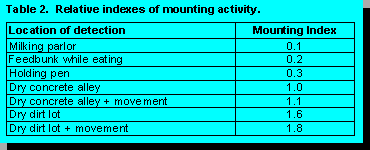
Activities or conditions that restrict interactions among cows influence whether cows show heat; therefore, heat checks should be scheduled to occur when cows are free to interact and not after they have been fed or when they are being moved or are crowded (1). Cows that are eating, crowded in holding pens or alleys do less mounting. Cows that are on slippery alleys, frozen ground or any surface that makes footing tenuous show less mounting activity. One study from our laboratory revealed that cows in heat are more likely to mount another cow in heat if the other cow is loose rather than tied (25). Perhaps this indicates that freedom to interact before mounting is important for maximum expression of mounting activity. Cows that have foot problems, regardless of whether the problem is structural, subclinical or clinical, apparently show poorer reproductive performance (5), and this may be related in part to poorer expression of estrus. Many of the foot problems that affect mounting activity can be alleviated by proper foot care (foot baths and trimming) and getting cows off concrete surfaces for detection of estrus.
There is no firm experimental evidence that high levels of milk production per se influence
mounting or standing activity. There is evidence that energy balance during the early
postpartum period may influence whether a cow is detected in heat at the beginning of the
first or second postpartum cycle (7, 21). Apparently cows experiencing a severe negative
energy balance can produce enough estrogen to elicit an LH surge, but the low energy
balance interferes with behavioral expression of heat. Similarly, there is evidence that
cows treated with bovine somatotropin may have poorer expression of estrus than
non-treated herdmates (13), probably because of differences in energy balance.

Certain kinds of stress may also suppress estrus or shorten its duration. Intact or ovariectomized estrogen-treated cows and heifers showed reduced expression of estrus when challenged with some hormones of the anterior pituitary-adrenal axis (2). Thus, either corticotropin or synthetic glucocorticoids (but not natural corticoids) reduced duration of estrus and altered the interval from induced luteolysis to estrus. These data provide circumstantial evidence that cattle subjected to stressful conditions that would activate the hypothalamic-pituitary- adrenal axis might show poorer signs of estrus.
Extremes in temperature affect intensity of heat. Mounting activity is lower on days when the ambient temperature is greater than or substantially lower than the cow's thermoneutral zone. Heats may appear to be shorter when the temperatures are extreme, but it isn't clear whether this is because of less mounting activity or because of less willingness to stand.
![]() Detection of Heat in Dairy
Herds
Detection of Heat in Dairy
Herds
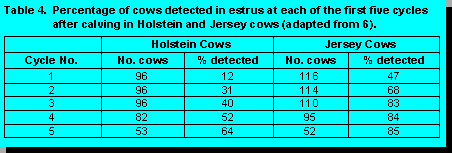
The duration of estrus ranges from about 3 to 24 hours with an average of about 12 to 15 hours for milking cows. Thus heats can be missed easily if observations are not scheduled properly and if conditions are not favorable for maximum expression of heat. The most important behavioral sign of heat requires that at least two animals interact, because a cow will not be detected to stand if there is no other animal willing to mount. Conception rates are higher for cows inseminated on the basis of standing heat than on the basis of secondary signs (19). Part of this may be due to fact that cows that are in heat for more than 12 hours (two twice-daily heat checks) apparently have higher fertility than those in heat at only one check. But a great deal of the differences among herds in conception rates is related to accuracy of detection and timing of insemination. Cows inseminated on the basis of standing-to-be-mounted are more likely to be in heat and are more likely to be bred at the correct time than those bred on the basis of other signs.
Heat detection accuracy is a major problem on many farms. On the average farm, about 10 to 20% of cows submitted for insemination have high levels of progesterone and therefore are not likely to be in heat (15). Even cows with low progesterone on the day of submission may not be in heat, because the period of low progesterone encompasses about five to seven days of a cycle. Milk progesterone testing can be a useful tool for improving accuracy of heat detection. Some pregnant cows with high levels of progesterone will show estrus (23). Estrus during pregnancy occurs more often after the fourth month of pregnancy, occurs more often in fourth or fifth parities, occurs when progesterone is high and estradiol generally low, and is of shorter duration (5.6 hr) than is typical for non-pregnant estrual cows. Pregnant cows that show estrus are part of the sexually active group, and some cows have been reported to show estrus repeatedly during consecutive pregnancies (23).
![]() Heat Detection
Aids
Heat Detection
Aids
![]() Hormonal-Controlled Estrus
Hormonal-Controlled Estrus
One of the main opportunities for use of estrous synchronizing hormones in dairy herds is for predictable induction of estrus in batches of cows or heifers for enhancement of efficiency of detection of estrus. The popularity of using such programs has increased in recent years, partly because of larger-sized herds and partly because of new systems for using the hormonal treatments. Typical programs include those in which eligible cows are set up by injection of a luteolytic prostaglandin about 17 days before the end of the voluntary waiting period and then these cows are given a second prostaglandin injection three days before breeding is to begin. Such treatments allow producers to focus heat-detection efforts on groups of cows at designated times, and in general such programs have been useful for reducing days open or increasing percentage of cows pregnant by three to five months postpartum. These programs require additional investments in drugs and veterinary costs and do not lower services per conception, but they do allow reproduction in the herd to be controlled in a more systematic way.
For nearly all estrous-synchronization systems, conception rate is better for cows inseminated on the basis of estrus that at a preselected time. The one exception to this is a system that was reported first in the summer of 1994 (16, 17). In this system, cows are given GnRH to induce emergence of a new wave of follicles (and in some cases ovulation), followed seven days later by prostaglandin to induce luteolysis, which is followed two days later by GnRH to induce ovulation and cows are inseminated 24 hours after this second GnRH, without regard to estrus. Early field trials of this system showed conception rates equal to those for cows inseminated at natural estrus and a 30 day reduction in days open among treated cows compared to their herdmates.
![]() Passive Mount Detectors
Passive Mount Detectors
Passive heat detection aids such as chalking, tail-painting and KaMaR Heatmount Detectors are beneficial for improving detection rate when combined with careful observation and good judgment (22). When such aids are used, accuracy of heat detection increases when more than one criterion is used to identify cows in estrus. When used alone, these aids may lead to a higher error rate and therefore no real improvement in detection rate over that of a casual system, unless their use is closely tied to programmed breeding where the time of estrus is highly predictable. For example, use of chalking or tail-painting in combination with prostaglandin or progestogens for synchronization of estrus may lead to detection of more animals in heat than would be the case with observation alone.
![]() Heat Detector Animals
Heat Detector Animals
Treatment of heifers or cull cows with testosterone enhances their sexual activity to the point where they act like bulls in search of estrual cows (10, 14). When fitted with halter-mounted marking devices, these detector animals provide around-the-clock surveillance for cows in heat. They improve accuracy of detection of estrus and show more mounting activity than normal cows or heifers. Heifers can be induced to be more sexually aggressive by inserting four implants containing 200 mg testosterone propionate and 160 mg estradiol benzoate into each ear. It is recommended that the implants be replaced every 90 days.
![]() Electronic Detection
Electronic Detection
Several electronic devices have been or are being developed for detection of estrus. This included devices for:
monitoring increased physical activity associated
with estrus (electronic pedometers),
detection of mounts (rump-mounted or implantable
devices),
detection of changes in electrical impedance in the
vaginal submucosa (20) or vaginal mucus, and
detection of changes in vaginal temperature (18).
The devices that are fixed to or implanted in the cow also include circuitry for electronic identification. Such systems require personal computer systems for electronically identifying cows and "reading" signals from the devices. These systems allow one to automate monitoring of estrus-related activities and to reduce time required for observation. Nevertheless, the rate of estrous detection of such systems seldom exceeds that which can be achieved by careful, systematic observation of cattle. Nearly all of the devices that capture activity or mounting information utilize algorithms to interpret the data, and there is still a need to develop better methods for distinguishing between estrual and non-estrual cows (12).
In loose-housed cattle or those that are turned out of tie-stall barns for at least five to eight hours daily, activity monitors (pedometers) and mount detectors accurately identify about 70% of heats (20). Devices that measure electrical impedance of the vaginal submucosa or vaginal mucus do not require that cows are free to interact. At present, there are no commercially-available implantable devices that measure impedance, and the vaginal probes for measuring electrical conductivity are labour intensive.
![]() Economics of Heat
Detection
Economics of Heat
Detection

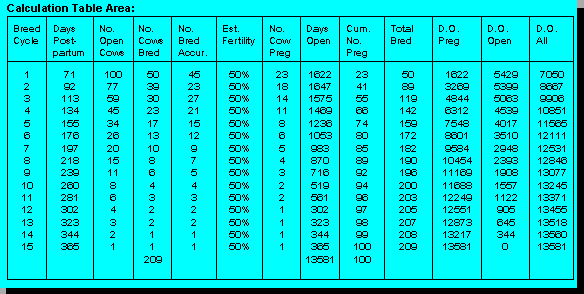

Fertility level of the herd was considered to be the innate fertility independent of errors in heat detection. Thus, herd fertility included effects due to herd health, heat stress, semen quality, skill of inseminators, production level, etc. It was varied from 30 to 90%, indicating that if detection was accurate 30 to 90% of the inseminations would result in conception. For this simulation, the voluntary waiting period was 60 days and cows were inseminated until 180 days postpartum. The economic data used in the simulations included costs per cow associated with more labor for heat detection (20› per minute) and $5 per cow for heat detection aids (for the Rigorous group).
The simulation indicated that returns to investments in heat detection programs were greatest in
situations where herd fertility was lower (Table 6). The relative net returns per cow for Systematic
and Rigorous heat detection programs decreased as herd fertility increased. 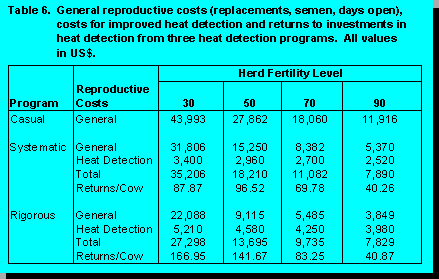 This is because high fertility leads to relatively good
reproductive performance even when submission rates and accuracy rates are low. The simulation
indicates that over US$100 per cow in net returns could accrue from improved heat detection
programs in herds with low to moderate fertility. Basically these returns arise because of more
opportunities to get the cow bred within the designated time span and lower heat detection error
rates that result in higher realized fertility.
This is because high fertility leads to relatively good
reproductive performance even when submission rates and accuracy rates are low. The simulation
indicates that over US$100 per cow in net returns could accrue from improved heat detection
programs in herds with low to moderate fertility. Basically these returns arise because of more
opportunities to get the cow bred within the designated time span and lower heat detection error
rates that result in higher realized fertility.
![]() References
References